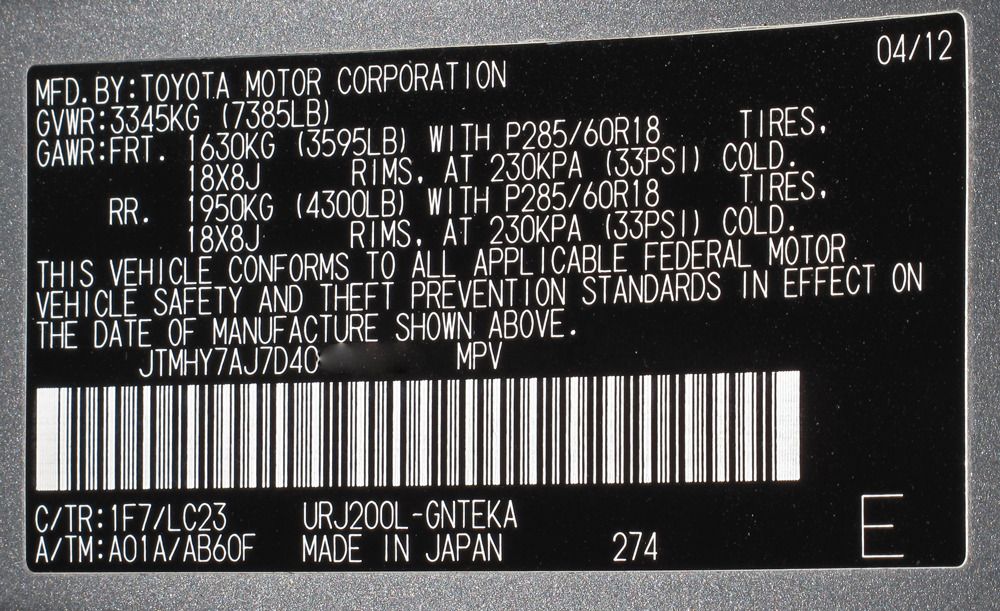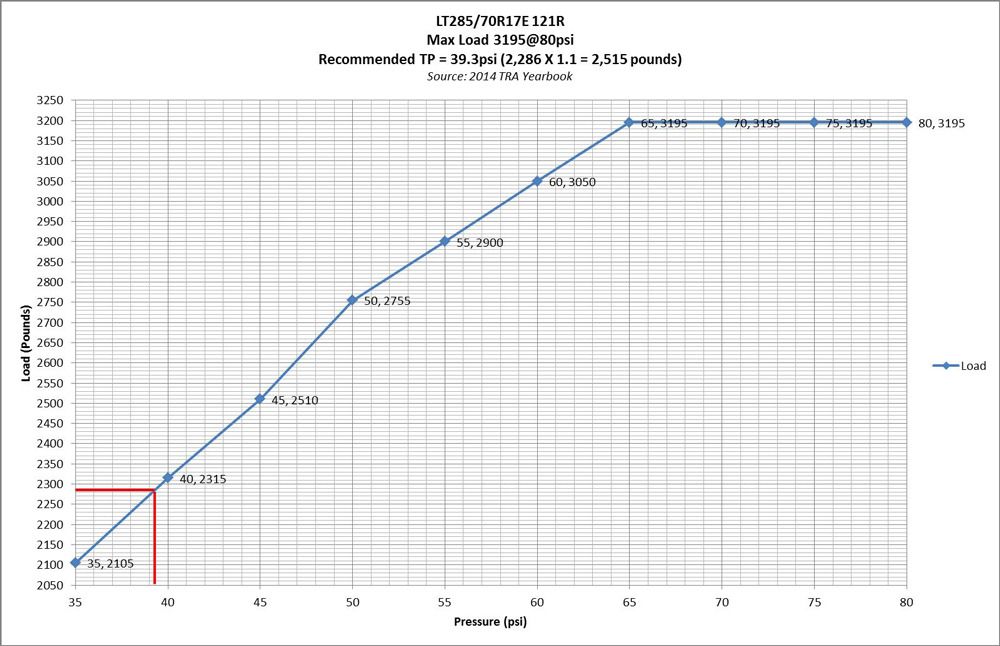OK, but buckle up folks, it's going to be a bumpy ride ...
Without specific vehicle/tire info, all I can do is provide generalized info based on a stock 2013 LC200 running LT285/70-17 tires. It should be enough to get a feel for what may apply in your individual case.
As a base, we have the door sticker for the LC200:
The sticker gives us some important info:
- GVWR = 7,385 lbs
- GAWR Front = 3,595 lbs
- GAWR Rear = 4,300 lbs
- Tire size = P285/60R18
- Cold Tire Pressure = 33psi Front/Rear
From this info, using published Load Limit tables, we can calculate the Load Limit which results from the recommended tire size and pressure:
This calculation yields a Load Limit of 2,512 lbs (per P-Rated tire) @ 33psi.
Since we are talking about a LT-Rated tire replacing a P-Rated tire in our hypothetical, we need to calculate the required Load Limit for a LT-Rated tire. When replacing a P-Rated tire with a LT-Rated tire, the LT-Rated tire should have a Load Limit 10% less than the P-Rated tire. Therefore in our example, the LT-Rated Load Limit is calulated as follows:
P-Rated Load Limit / 1.1 (the 10% difference) = LT-Rated Load Limit
-or-
2,512 lbs per tire / 1.1 = 2,284 lbs per tire
Using this new LT-Rated Load Limit, again using published Load Limit tables, we can calculate the Cold Tire Pressure required to yield the required Load Limit. For the LT285/70-17 tires, it looks like this:
From the graph, we can see that approximately 39.3psi yields a Load Limit of 2,286 lbs which, when corrected for the P-Rated requirement = 2,515 lbs compared to the P-Rated requirement of 2,512 lbs. For simplicity, let's round up and call it 40psi.
It makes no difference whether the LT285/70-17 tire is D-Rated or E-Rated, the required pressure is the same.
**********
What we know now is:
For a stock LC200 running LT285/70-17 tires, the required Cold Tire Pressure is 40psi Front/Rear.
**********
Now, we can look at what might be appropriate for a LC200 which has additional weight added to it.
Relax, we've already slogged through the tough stuff - the rest is easy.
Examining the Load Limit graph for the LT-Rated tire above, we see the load Limits are approximately as follows at the indicated Cold Tire Pressures:
40psi = 2,315 lbs/tire -or- 9,260 lbs Total
45psi = 2,510 lbs/tire -or- 10,040 lbs Total -or- 780 lbs more than stock
50psi = 2,755 lbs/tire -or- 11,020 lbs Total -or- 1,760 lbs more than stock
So, roughly speaking:
- If you have added 780 lbs to your rig, you should be running 45psi instead of 40psi.
- If you have added 1,760 lbs to your rig, you should be running 50psi instead of 40psi.
But what if you have added a weight somewhere between the published 5psi increments?
It's not exact, but a simple calculation could be applied.
Let's say you've added 1,000 lbs to your rig.
Already you know you should be running somewhere between 45psi and 50psi. Between 45psi and 50psi, we see a difference of (11,020 lbs - 10,040 lbs = ) 980 lbs. 980 / 5 = 196 lbs per psi.
So, 1,000 lbs (desired increased capacity) - 780 lbs (added capacity @ 45psi) = 220 lbs / 196 (lbs/psi between 45psi and 50psi) = 1.12psi above 45psi = 46.12psi will yield a capacity 1,000 lbs above stock.
See? Easy, right?
HTH




